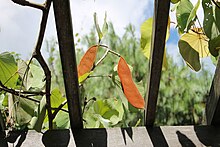en
names in breadcrumbs


Phanera vahlii (common name Camel's Foot Climber)is a perennial creeper of the family Fabaceae native to the Indian subcontinent. It can grow as much as fifty feet (15 meters) a year. The two-lobed leaves are up to 18 inches (46 centimeters) in length. The stems and petioles are covered with reddish hair (trichomes).[5]
The roasted seeds of this woody climber are edible.[6]
Phanera species have 2–3 fertile stamens.[7]
Phanera vahlii is found from Sikkim and Nepal across India and Himachal Pradesh and Punjab, Pakistan.
In Hindi, it is called मालू malu, but also mahul, jallaur and jallur. In Nepali it is called भोर्ला bhorla. In Odia, it is called ; ସିଆଳି Siali, இலை மந்தாரை in Tamil. In Telugu, it is called అడ్డాకు.
 Pods of Phanera vahlii in Mathurapati Fulbari VDC Nepal
Pods of Phanera vahlii in Mathurapati Fulbari VDC Nepal Phanera vahlii (common name Camel's Foot Climber)is a perennial creeper of the family Fabaceae native to the Indian subcontinent. It can grow as much as fifty feet (15 meters) a year. The two-lobed leaves are up to 18 inches (46 centimeters) in length. The stems and petioles are covered with reddish hair (trichomes).
The roasted seeds of this woody climber are edible.
Phanera species have 2–3 fertile stamens.